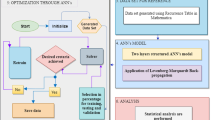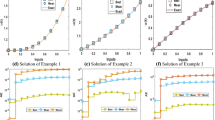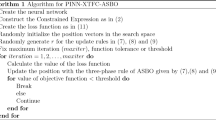Abstract
The aim of this study is to present a novel application of Levenberg–Marquardt backpropagation (LMB) to investigate numerically the solution of functional differential equations (FDE) arising in quantum calculus models (QCMs). The various types of discrete versions of FDM in QCMs are always found to be stiff to solve due to involvement of delay and to overcome the said difficulty, we proposed intelligent computing platform via LMB networks. In order to generate dataset for LMB networks, firstly, the FDEs in QCMs are converted into recurrence relations, then these recurrence systems are solved numerically on a specific input grids in case of both types of FDEs with q-exponential function as well as stable with decreasing behavior characteristics. The training, testing and validation samples based processes are employed to construct LMB networks by exploiting approximation theory on mean square error sense for obtaining the solutions of both types of FDEs. The exhaustive conducted simulation studies for solving FDEs in QCMs via absolute error and mean squared error endorse the accuracy, potential, convergence, stability and worth of proposed technique, which further certified through viable training state parameters, outcomes of error histograms, values of regression/correlation indices.











Similar content being viewed by others
Data Availability Source
No data is associated with this study.
References
Adel W, Sabir Z (2020a) Solving a new design of nonlinear second-order Lane–Emden pantograph delay differential model via Bernoulli collocation method. Eur Phys J Plus 135(5):1–12
Adel W, Sabir Z (2020b) Solving a new design of nonlinear second-order Lane–Emden pantograph delay differential model via Bernoulli collocation method. Eur Phys J Plus 135(5):1–12
Ahmad I, Asad SM (2020) Predictions of coronavirus COVID-19 distinct cases in Pakistan through an artificial neural network. Epidemiol Infect 148:e222
Ahmad I, Ahmad F, Bilal M et al (2020a) Neuro-heuristic computational intelligence for nonlinear Thomas–Fermi equation using trigonometric and hyperbolic approximation. Measurement 156:107549
Ahmad I, Qureshi H, Bilal M et al (2020b) Stochastic technique for solutions of non-linear fin equation arising in thermal equilibrium model. Therm Sci 24(5 Part A):3013–3022
Ahmad I, Ahmad SuI, Kutlu K et al (2021a) On the dynamical behavior of nonlinear Fitzhugh–Nagumo and Bateman–Burger equations in quantum model using Sinc collocation scheme. Eur Phys J Plus 136(11):1108
Ahmad I, Cheema TN, Raja MAZ et al (2021b) A novel application of Lobatto IIIA solver for numerical treatment of mixed convection nanofluidic model. Sci Rep 11(1):4452
Ahmad I, Ilyas H, Raja MAZ et al (2021c) Stochastic numerical computing with Levenberg–Marquardt backpropagation for performance analysis of heat sink of functionally graded material of the porous fin. Surf Interfaces 26:101403
Ahmad I, Raja MAZ, Ramos H et al (2021d) Integrated neuro-evolution-based computing solver for dynamics of nonlinear corneal shape model numerically. Neural Comput Appl 33:5753–5769
Ahmad I, Ilyas H, Raja MAZ et al (2022) Intelligent computing based supervised learning for solving nonlinear system of malaria endemic model. AIMS Math 7(11):20341–20369
Ali S, Raja MAZ, Cheema TN et al (2021) Analysis of Williamson nanofluid with velocity and thermal slips past over a stretching sheet by Lobatto IIIA numerically. Therm Sci 25(4 Part A):2795–2805
Almutairi OB (2022) Quantum estimates for different type intequalities through generalized convexity. Entropy 24(5):728
Alp N, Budak H, Erden S et al (2022) New bounds for q-midpoint-type inequalities via twice q-differentiable functions on quantum calculus. Soft Comput 26(19):10321–10329
Ansari H, Mokhtary P (2019) Computational Legendre Tau method for Volterra Hammerstein pantograph integral equations. Bull Iran Math Soc 45:475–493
Arbi A, Tahri N (2022) New results on time scales of pseudo Weyl almost periodic solution of delayed QVSICNNs. Comput Appl Math 41(6):293
Asghar SA, Naz S, Raja MAZ (2023) Intelligent computing with the knack of Bayesian neural networks for functional differential systems in quantum calculus model. Int J Mod Phys B 37(22):2350217
Bahgat MS (2020) Approximate analytical solution of the linear and nonlinear multi-pantograph delay differential equations. Phys Scr 95(5):055219
Bhatia M, Bhatia S, Hooda M et al (2022) Analyzing and classifying MRI images using robust mathematical modeling. Multimed Tools Appl 81(26):37519–37540
Botmart T, Sabir Z, Raja MAZ et al (2022) A numerical study of the fractional order dynamical nonlinear susceptible infected and quarantine differential model using the stochastic numerical approach. Fractal Fract 6(3):139
Bukhari AH, Raja MAZ, Sulaiman M et al (2020a) Fractional neuro-sequential ARFIMA-LSTM for financial market forecasting. IEEE Access 8:71326–71338
Bukhari AH, Sulaiman M, Raja MAZ et al (2020b) Design of a hybrid NAR-RBFs neural network for nonlinear dusty plasma system. Alex Eng J 59(5):3325–3345
Bukhari AH, Raja MAZ, Rafiq N et al (2022) Design of intelligent computing networks for nonlinear chaotic fractional Rossler system. Chaos Solitons Fractals 157:111985
Butt ZI, Ahmad I, Shoaib M et al (2022) Electro-magnetohydrodynamic impact on Darrcy–Forchheimer viscous fluid flow over a stretchable surface: integrated intelligent neuro-evolutionary computing approach. Int Commun Heat Mass Transf 137:106262
Chakraborty R, Verma G, Namasudra S (2021) IFODPSO-based multi-level image segmentation scheme aided with Masi entropy. J Ambient Intell Humaniz Comput 12:7793–7811
Chaudhary NI, Khan ZA, Kiani AK et al (2022) Design of auxiliary model based normalized fractional gradient algorithm for nonlinear output-error systems. Chaos Solitons Fractals 163:112611
Chen Z (2022) Research on internet security situation awareness prediction technology based on improved RBF neural network algorithm. J Comput Cogn Eng 1(3):103–108
Deng Y, Zhou X, Shen J et al (2021) New methods based on back propagation (BP) and radial basis function (RBF) artificial neural networks (ANNs) for predicting the occurrence of haloketones in tap water. Sci Total Environ 772:145534
Ezz-Eldien SS, Doha EH (2019) Fast and precise spectral method for solving pantograph type Volterra integro-differential equations. Numer Algorithms 81:57–77
Fečkan M, Wang J, Zhao HY (2021) Maximal and minimal nondecreasing bounded solutions of iterative functional differential equations. Appl Math Lett 113:106886
Gao Y, Jia L (2023) Stability in distribution for uncertain delay differential equations based on new Lipschitz condition. J Ambient Intell Humaniz Comput 14(10):13585–13599
Griebel T (2017) The pantograph equation in quantum calculus. Missouri University of Science and Technology, Rolla
Guo P, Li CJ (2019a) Almost sure stability with general decay rate of exact and numerical solutions for stochastic pantograph differential equations. Numer Algorithms 80:1391–1411
Guo P, Li CJ (2019b) Razumikhin-type theorems on the moment stability of the exact and numerical solutions for the stochastic pantograph differential equations. J Comput Appl Math 355:77–90
Hou CC, Simos TE, Famelis IT (2020) Neural network solution of pantograph type differential equations. Math Methods Appl Sci 43(6):3369–3374
Ilyas H, Ahmad I, Raja MAZ et al (2021a) A novel design of Gaussian WaveNets for rotational hybrid nanofluidic flow over a stretching sheet involving thermal radiation. Int Commun Heat Mass Transf 123:105196
Ilyas H, Ahmad I, Raja MAZ et al (2021b) Intelligent computing for the dynamics of fluidic system of electrically conducting Ag/Cu nanoparticles with mixed convection for hydrogen possessions. Int J Hydrog Energy 46(7):4947–4980
Ilyas H, Ahmad I, Raja MAZ et al (2021c) Intelligent networks for crosswise stream nanofluidic model with Cu–H\(_2\)O over porous stretching medium. Int J Hydrog Energy 46(29):15322–15336
Ilyas H, Raja MAZ, Ahmad I et al (2021d) A novel design of gaussian wavelet neural networks for nonlinear Falkner–Skan systems in fluid dynamics. Chin J Phys 72:386–402
Jafari H, Tuan N, Ganji R (2021) A new numerical scheme for solving pantograph type nonlinear fractional integro-differential equations. J King Saud Univ Sci 33(1):101185
Jafarian A, Rezaei R, Khalili Golmankhaneh A (2022) On solving fractional higher-order equations via artificial neural networks. Iran J Sci Technol Trans A: Sci 46(2):535–545
Jia D (2022) Time-space duality in 2D quantum gravity. Class Quantum Gravity 39(3):035016
Jia ZA, Yi B, Zhai R et al (2019) Quantum neural network states: a brief review of methods and applications. Adv Quantum Technol 2(7–8):1800077
Jin T, Xia H (2023) Lookback option pricing models based on the uncertain fractional-order differential equation with Caputo type. J Ambient Intell Humaniz Comput 14(6):6435–6448
Karthik P, Sekhar K (2021) Resource scheduling approach in cloud testing as a service using deep reinforcement learning algorithms. CAAI Trans Intell Technol 6(2):147–154
Khan I, Raja MAZ, Shoaib M et al (2020) Design of neural network with Levenberg–Marquardt and Bayesian regularization backpropagation for solving pantograph delay differential equations. IEEE Access 8:137918–137933
Liu Z, Kang R (2023) Michaelis–Menten pharmacokinetics based on uncertain differential equations. J Ambient Intell Humaniz Comput 14(8):10403–10415
Lodhi S, Manzar MA, Raja MAZ (2019) Fractional neural network models for nonlinear Riccati systems. Neural Comput Appl 31:359–378
Mouktonglang T, Sabir Z, Raja MAZ et al (2023) Designing Meyer wavelet neural networks for the three-species food chain model. AIMS Math 8(1):61–75
Muhuri S, Kumari S, Namasudra S, Kadry S (2022) Analysis of the pertinence of indian women’s institutions in collaborative research. IEEE Trans Comput Soc Syst. https://doi.org/10.1109/TCSS.2022.3183949
Mukdasai K, Sabir Z, Raja MAZ et al (2022) A numerical simulation of the fractional order leptospirosis model using the supervise neural network. Alex Eng J 61(12):12431–12441
Nawaz Y, Arif MS, Abodayeh K (2022) A compact numerical scheme for the heat transfer of mixed convection flow in quantum calculus. Appl Sci 12(10):4959
Nouri K, Ranjbar H, Torkzadeh L (2020) Solving the stochastic differential systems with modified split-step Euler–Maruyama method. Commun Nonlinear Sci Numer Simul 84:105153
Ockendon JR, Tayler AB (1971) The dynamics of a current collection system for an electric locomotive. Proc R Soc Lond A Math Phys Sci 322(1551):447–468
Rabiei K, Ordokhani Y (2019) Solving fractional pantograph delay differential equations via fractional-order Boubaker polynomials. Eng Comput 35(4):1431–1441
Radha B, Duraisamy C (2021) The homogeneous balance method and its applications for finding the exact solutions for nonlinear equations. J Ambient Intell Humaniz Comput 12:6591–6597
Raja MAZ, Mehmood A, Ashraf S et al (2022a) Design of evolutionary finite difference solver for numerical treatment of computer virus propagation with countermeasures model. Math Comput Simul 193:409–430
Raja MAZ, Shoaib M, Tabassum R et al (2022b) Stochastic numerical computing for entropy optimized of Darcy–Forchheimer nanofluid flow: Levenberg Marquardt algorithm. Chem Phys Lett 807:140070
Raja MAZ, Tabassum R, El-Zahar ER et al (2022c) Intelligent computing through neural networks for entropy generation in MHD third-grade nanofluid under chemical reaction and viscous dissipation. Waves Random Complex Media 1–25. https://doi.org/10.1080/17455030.2022.2044095
Rizwan A, Ahmad I, Raja MAZ et al (2021) Design of spline-evolutionary computing paradigm for nonlinear thin film flow model. Arab J Sci Eng 46(9):9279–9299
Sabir Z, Raja MAZ, Umar M et al (2020a) Design of neuro-swarming-based heuristics to solve the third-order nonlinear multi-singular Emden–Fowler equation. Eur Phys J Plus 135(5):410
Sabir Z, Raja MAZ, Umar M et al (2020b) Design of neuro-swarming-based heuristics to solve the third-order nonlinear multi-singular Emden–Fowler equation. Eur Phys J Plus 135(5):410
Sabir Z, Raja MAZ, Umar M et al (2020c) Neuro-swarm intelligent computing to solve the second-order singular functional differential model. Eur Phys J Plus 135:1–19
Sabir Z, Saoud S, Raja MAZ et al (2020d) Heuristic computing technique for numerical solutions of nonlinear fourth order Emden–Fowler equation. Math Comput Simul 178:534–548
Sabir Z, Wahab HA, Umar M et al (2020e) Novel design of Morlet wavelet neural network for solving second order Lane–Emden equation. Math Comput Simul 172:1–14
Sabir Z, Raja MAZ, Wahab HA et al (2021) Integrated intelligence of neuro-evolution with sequential quadratic programming for second-order Lane–Emden pantograph models. Math Comput Simul 188:87–101
Sabir Z, Botmart T, Raja MAZ et al (2022a) Artificial neural network scheme to solve the nonlinear influenza disease model. Biomed Signal Process Control 75:103594
Sabir Z, Raja MAZ, Mahmoud SR et al (2022b) A novel design of Morlet wavelet to solve the dynamics of nervous stomach nonlinear model. Int J Comput Intell Syst 15(1):4
Sabir Z, Ali MR, Sadat R (2023) Gudermannian neural networks using the optimization procedures of genetic algorithm and active set approach for the three-species food chain nonlinear model. J Ambient Intell Humaniz Comput 14(7):8913–8922
Sana G, Noor MA, Baleanu D (2021) Novel higher order iterative schemes based on the q-calculus for solving nonlinear equations. http://hdl.handle.net/20.500.12416/5744 (Online)
Shahid F, Zameer A, Mehmood A et al (2020) A novel wavenets long short term memory paradigm for wind power prediction. Appl Energy 269:115098
Shaimardan S, Tokmagambetov NS (2022) The Schrödinger equations generated by g-Bessel operator in quantum calculus. Of the Karaganda University, p 102. https://doi.org/10.31489/2022M1/102-108
Shoaib M, Naz S, Raja MAZ et al (2022) A design of soft computing intelligent networks for MHD Carreau nanofluid model with thermal radiation. Int J Mod Phys B 36(27):2250192
Sinha A (1993) Stabilisation of time-varying infinite delay control systems. In: IEEE proceedings D (control theory and applications). IET, London, UK, pp 60–63
Sun B, Cao Y, Guo Z et al (2020a) Synchronization of discrete-time recurrent neural networks with time-varying delays via quantized sliding mode control. Appl Math Comput 375:125093
Sun B, Wen S, Wang S et al (2020b) Quantized synchronization of memristive neural networks with time-varying delays via super-twisting algorithm. Neurocomputing 380:133–140
Umar M, Raja MAZ, Sabir Z et al (2020a) A stochastic computational intelligent solver for numerical treatment of mosquito dispersal model in a heterogeneous environment. Eur Phys J Plus 135(7):1–23
Umar M, Sabir Z, Amin F et al (2020b) Stochastic numerical technique for solving HIV infection model of CD4\(^{+}\) T cells. Eur Phys J Plus 135:1–19
Umar M, Sabir Z, Raja MAZ et al (2020c) A stochastic intelligent computing with neuro-evolution heuristics for nonlinear SITR system of novel COVID-19 dynamics. Symmetry 12(10):1628
Umar M, Sabir Z, Raja MAZ et al (2021) Neuro-swarm intelligent computing paradigm for nonlinear HIV infection model with CD4+ T-cells. Math Comput Simul 188:241–253
Verma R, Kumari A, Anand A et al (2024) Revisiting shift cipher technique for amplified data security. J Comput Cogn Eng 3(1):8–14
Viera-Martin E, Gómez-Aguilar J, Solís-Pérez J et al (2022) Artificial neural networks: a practical review of applications involving fractional calculus. Eur Phys J Spec Top 231(10):2059–2095
Wake G, Cooper S, Kim H et al (2000) Functional differential equations for cell-growth models with dispersion. Commun Appl Anal 4(4):561–574
Wang Y, Cao Y, Guo Z et al (2020) Passivity and passification of memristive recurrent neural networks with multi-proportional delays and impulse. Appl Math Comput 369:124838
Yang C, Lv X (2021) Generalized Jacobi spectral Galerkin method for fractional pantograph differential equation. Math Methods Appl Sci 44(1):153–165
Yang X, Yang Z, Xiao Y (2022) Asymptotical mean-square stability of linear \(\theta \)-methods for stochastic pantograph differential equations: variable stepsize and transformation approach. Int J Comput Math 99(4):759–770
Zhan W, Gao Y, Guo Q et al (2019) The partially truncated Euler–Maruyama method for nonlinear pantograph stochastic differential equations. Appl Math Comput 346:109–126
Zhao W, Rexma Sherine V, Gerly T et al (2022) Symmetric difference operator in quantum calculus. Symmetry 14(7):1317
Zhu W, Xian L, Wang E et al (2019) Learning classification of big medical imaging data based on partial differential equation. J Ambient Intell Humaniz Comput 1–10. https://doi.org/10.1007/s12652-019-01185-6
Zhu J, Ma X, Lin Z, De Meo P (2023) A quantum‐like approach for text generation from knowledge graphs. CAAI Trans Intell Technol 8(4):1455–1463
Author information
Authors and Affiliations
Corresponding author
Ethics declarations
Conflict of interest
There is no any conflict of the interest.
Additional information
Publisher's Note
Springer Nature remains neutral with regard to jurisdictional claims in published maps and institutional affiliations.
Rights and permissions
Springer Nature or its licensor (e.g. a society or other partner) holds exclusive rights to this article under a publishing agreement with the author(s) or other rightsholder(s); author self-archiving of the accepted manuscript version of this article is solely governed by the terms of such publishing agreement and applicable law.
About this article
Cite this article
Asghar, S.A., Ilyas, H., Naz, S. et al. Intelligent predictive computing for functional differential system in quantum calculus. J Ambient Intell Human Comput 15, 2153–2168 (2024). https://doi.org/10.1007/s12652-023-04744-0
Received:
Accepted:
Published:
Issue Date:
DOI: https://doi.org/10.1007/s12652-023-04744-0




